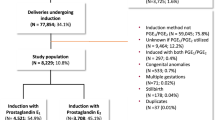Abstract
Objective:
To assess the risk of nighttime delivery associated with timing and method of labor induction.
Study Design:
We reviewed records of 692 patients undergoing full, late or post-term labor induction at two large hospitals. Primary independent variables were start time (morning or evening) and method (prostaglandin or oxytocin). Relative risk was assessed for the primary outcome of nighttime delivery.
Result:
Two hundred and ninety-seven (42.9%) patients experienced nighttime delivery. The relative risk of nighttime delivery adjusted for age in multiparous women using oxytocin in the morning compared with oxytocin inductions in the evening was 0.31 (95% confidence interval (CI): 0.22 to 0.45). Among nulliparous women in the same group, the adjusted relative risk was 0.65 (95% CI: 0.36 to 1.19). For prostaglandin inductions, there was no difference in the risk of nighttime delivery based on timing of the induction in the evening (relative risk: 0.89; 95% CI: 0.71 to 1.10).
Conclusion:
The method used and the time at which induction is started affect risk of nighttime delivery. For multiparous patients receiving oxytocin, morning induction carries lower risk of nighttime delivery. For prostaglandins, timing of initiation did not affect risk of nighttime delivery.
This is a preview of subscription content, access via your institution
Access options
Subscribe to this journal
Receive 12 print issues and online access
$259.00 per year
only $21.58 per issue
Buy this article
- Purchase on Springer Link
- Instant access to full article PDF
Prices may be subject to local taxes which are calculated during checkout
Similar content being viewed by others
References
Osterman MJ, Martin JA . Recent declines in induction of labor by gestational age. NCHS Data Brief 2014; 155: 1–8.
Gould JB, Qin C, Chavez G . Time of birth and the risk of neonatal death. Obstet Gynecol 2005; 106: 352–358.
Stewart JH, Andrews J, Cartlidge PH . Numbers of deaths related to intrapartum asphyxia and timing of birth in all Wales perinatal survey, 1993–5. BMJ 1998; 316: 657–660.
Heller G, Misselwitz B, Schmidt S . Early neonatal mortality, asphyxia related deaths, and timing of low risk births in Hesse, Germany, 1990-8: observational study. BMJ 2000; 321: 274–275.
Stephansson O, Dickman PW, Johansson AL, Kieler H, Cnattingius S . Time of birth and risk of intrapartum and early neonatal death. Epidemiology 2003; 14: 218–222.
Luo ZC, Karlberg J . Timing of birth and infant and early neonatal mortality in Sweden 1973–95: longitudinal birth register study. BMJ 2001; 323: 1327–1330.
Wu YW, Pham TN, Danielsen B, Towner D, Smith L, Johnston SC . Nighttime delivery and risk of neonatal encephalopathy. Am J Obstet Gynecol 2011; 204: 37–38.
de Graaf JP, Ravelli AC, Visser GH, Hukkelhoven C, Tong WH, Bonsel GJ et al. Increased adverse perinatal outcome of hospital delivery at night. BJOG 2010; 117: 1098–1107.
Pasupathy D, Wood AM, Pell JP, Mechan H, Fleming M, Smith GC . Time of birth and risk of neonatal death at term: retrospective cohort study. BMJ 2010; 341: c3498.
Gaba DM, Howard SK . Patient safety: fatigue among clinicians and the safety of patients. N Engl J Med 2002; 347: 1249–1255.
Thorsell M, Lyrenas S, Andolf E, Kaijser M . Starting time for induction of labor and the risk for night-time delivery. Sex Reprod Health 2011; 2 (3): 113–117.
Oei SG, Jongmans L, Mol BW . Randomized trial of administration of prostaglandin E2 gel for induction of labor in the morning or the evening. J Perinat Med 2000; 28 (1): 20–25.
Bakker JJ, van der Goes BY, Pel M, Mol BW, van der Post JA . Morning versus evening induction of labour for improving outcomes. Cochrane Database Syst Rev 2013; 2: CD007707.
Dodd JM, Crowther CA, Robinson JS . Morning compared with evening induction of labor: a nested randomized controlled trial. Obstet Gynecol 2006; 108 (2): 350–360.
Bakker JJ, De Vos R, Pel M, Wisman C, Van Lith JM, Mol BW et al. Start of induction of labour with oxytocin in the morning or in the evening. A randomized controlled trial. BJOG 2009; 116 (4): 562–568.
Author information
Authors and Affiliations
Corresponding author
Ethics declarations
Competing interests
The authors declare no conflict of interest.
Additional information
The findings of this study were presented at the Annual Clinical and Scientific Meeting of the American Congress of Obstetricians and Gynecologists, 2–6 May 2015. The accompanying abstract for the presentation was published in a supplement to Obstetrics & Gynecology, May 2015.
Rights and permissions
About this article
Cite this article
Namaky, D., Franzese, J. & Eschenbacher, M. Timing of induction of labor and association with nighttime delivery: a retrospective cohort. J Perinatol 35, 1011–1014 (2015). https://doi.org/10.1038/jp.2015.135
Received:
Revised:
Accepted:
Published:
Issue Date:
DOI: https://doi.org/10.1038/jp.2015.135
This article is cited by
-
A model to predict delivery time following induction of labor at term with a dinoprostone vaginal insert: a retrospective study
Irish Journal of Medical Science (1971 -) (2024)
-
A mathematical model to predict mean time to delivery following cervical ripening with dinoprostone vaginal insert
Scientific Reports (2019)



